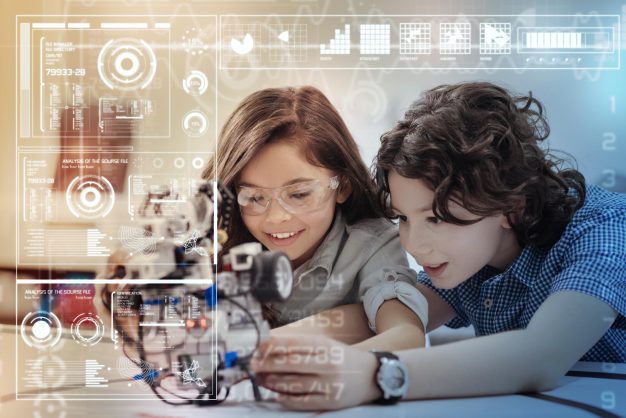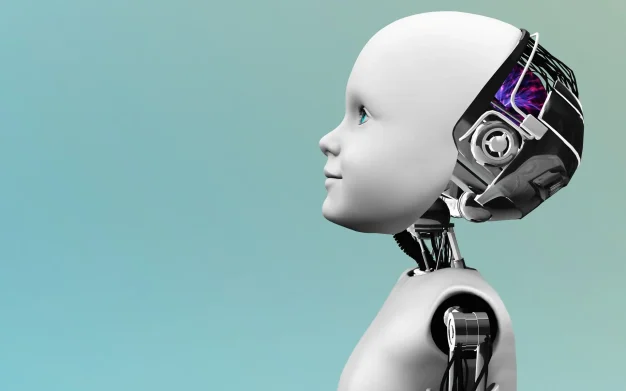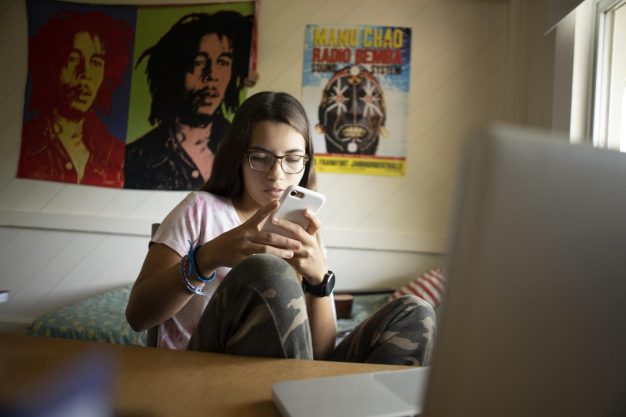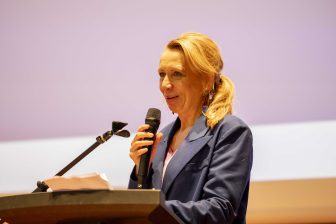
Previewing Dublin 2022 – Artificial intelligence through the lens of children’s rights
Making Connections is the theme for the forthcoming Child in the City World Conference – and it’s a topic which resonates on many levels. One of these is the world of digital technology and how it impacts on youngsters’ lives. We are delighted that Rosanna Di Gioia, a researcher with the European Commission, will be joining us in Dublin from October 5-7. Ahead of the conference, we spoke to her colleague, Stephane Chaudron, about some of the key strands of their work together.
CiTC: Can you please give us an outline of your role, and also that of the specific department and/or organisation you work for?
Stephane Chaudron: I am a researcher at the Joint Research Centre (JRC), the European Commission’s science and knowledge service, more specifically my work is part of the one of its Unit dedicated to Digital Citizens and Cyber security. With my team, I have been exploring the relationship between children and the digital world for the last ten years, its challenges, opportunities and risks and how it is changing, especially since the Covid crisis, and what it might mean for the future. The ultimate goal of my research is to provide evidence-based scientific support to the European policymaking process.
CiTC: The theme of our conference in Dublin is ‘Making Connections’, and is focused on how we make connections not only between children and cities, but also the different disciplines and professionals. Can you describe how your presentation theme & particular stream of work ties in with the aims of what our event hopes to achieve?
SC: Making connections lies at the centre of my studies on digital technology and their use by children. On one hand, because an important part of children’s use of digital technology aims at making connections, connections with friends, family members, or their school or other services of the city (especially since the COVID crisis). On the other hand, acting on the challenges that we see emerging from this usage – such as overuse, contact with inappropriate content, misinformation, bullying – demand actions from an entire eco-systems in which children live. Therefore, making a better digital world for children request exchange of information, connections and dialogues of/ in between different stakeholders (children, parents, teachers, carers, paediatricians, psychologists, NGOs, industry, policymakers). The difficulty here resides at first in defining common grounds, acknowledging issues for in second time defining strategies and actions to overcome them in constant dialogue. The aim with our presentation is to provide seeds for enabling this dialogue between stakeholders.
CiTC: Could we, as a society, have been better prepared for the challenges that Covid presented for children and how we ensured their continuity of learning? What key lessons have we learned that we could have done better?
SC: It is very difficult to be prepared for events that have little likelihood to occur. This is why, when a crisis strikes, society taps in the available resources. Naturally, digital technology presented itself as a valid solution to ensure a form of continuity of learning, but still in many instances, the school system was not ready.
For the last ten years, digital technology entered increasingly in the homes and lives of the vast majority of children across Europe from a young age, when touch-screen technology turned the use of smartphones and tablets, literally, into child’s play.
The integration of the technology within school practices showed more disparities. At the scale of Europe, schools in northern European countries benefitted from an earlier and larger adoption of the technology by its population and saw a higher rate of meaning full use of digital technology in classes, since kindergarten than western and southern countries which were relying more protectively on paper based methods. Eastern countries, keen on experimenting new possibilities offered by the technology, had to face more strongly than others the limitations that the costs of the technology itself and keeping pace with its evolution represents.

The lockdown situation pushed schools to shift their practices and go remote, for the most, then hybrid. School communities that already had a foot in the digital transformation suffered less in the adaptation than the others that had more to acquire and learn. In many instances, new material had to be bought or borrowed, teachers had to adapt deeply and quickly, parents, of young children especially, shifted roles and supported their children in their schooling time and activities, some revised their opinion about digital technology and its place in their children’s lives. This immense collective effort managed to keep most of the schooling process rolling. Yet, some children got lost on the way and pre-existing inequalities grow larger.
The lessons learned are many among which I can cite the need for
- ‘Digital savvy’ Teachers: There is a need of developing and integrating further the digital dimension of the teacher profession, for all teachers, from kindergarten, within initial and life-long-learning teacher training.
- Internet for all schools/children: there is a need for better and affordable internet connection and internet devices, for support of low SES families as well as families with numerous children.
- Digital balance: On average, with more than 6.5 hours per day, children’s screen-doubled in the lockdown, and half of this time was dedicated to school activities. The sudden shift saw the adoption of a multiplicity of platforms and tools and participated largely in the digital fatigue that appeared frequently after some weeks of remote schooling.
- Green and energy saving technology: in the climate change and war context, more than ever, there is a need for low-energy consumption and long life-cycle technology. Having systems that last longer will also support teachers’ training and the access of internet to all children, avoiding their knowledge/devices to be obsolete too quickly.

Stephane Chaudron
CiTC: What were the main ways in which children experienced online risks during the COVID lockdowns?
SC: In the KiDiCoTi study, we specifically measured children’s experiences and perceptions on screen excessive use, cyberbullying, cyberhate, disinformation, misuses of personal data, cybersecurity; the change they perceived in this kind of experience during lockdown compared to the previous period; and parents and children’s reactions to mitigate online risk.
Children, time spent online and excessive use
● First, regarding the online context that the lockdown enforced on children at home, results of the study show that children aged between 10 and 18 years old spend on average 6.5 to 7 hours on a weekday online during the first lockdown period. Half of this time was dedicated to school related activities.
● The majority of the surveyed children felt like they spent too much time using the internet or digital devices (77 per cent) and nearly half (48 per cent) felt an increase of this feeling during the lockdown period.
● Parents worrying about the time their children spent online were even more numerous (86 per cent) and nearly half of parents (48 per cent) worried more about an excessive use of the technology by their children during lockdown compared to the previous report.
● Effectively, half of the children declared having gone without eating or sleeping because of the internet, and a quarter of respondents declared an increase of this behaviour during the lockdown period. More than two-thirds of children (70 per cent) reported having failed in trying to reduce the time spent online and a third (34 per cent) noticed to struggle even more during the lockdown period.

Rosanna Di Gioia
Children and other online risks
Overall, three out five children felt safe using the internet, while two out of five young
users reported to feel some danger in the online space. Further analysis helped us to
understand more specifically from where this relative feeling of insecurity can come.
- Disinformation is the experience that children felt encountering and reported the
most (75 per cent) and during lockdown, more than a third (37 per cent) felt an increase of that
experience.
● Hate-speech is the second risk that children most reported (60 per cent) and more than
a quarter (28 per cent) reported to have seen an increase of hate messages that attack
certain groups or individuals (e.g people of different colour, religion, nationality or
sexuality)
● Violent or gory content follows, with more than half of children (55 per cent) reporting
to have already seen gory or violent images online such as hurting other people or
animals, for example. A quarter of children (21 per cent) stated a noticeable increase of
this type of experience during the lockdown compared to the previous period.
● Self-harm content shows lower figures. Nearly half of children (45 per cent) declared
having already seen people talk about or show ways for physically harming or
hurting themselves. Nearly a fifth (18 per cent) reported an increase of this type of
experience during lockdown.
● The cybersecurity risk of using a device that suffered from a virus or a
spyware has been relayed by nearly half of the young users (44 per cent), a sixth (14 per cent)
noticed an increase of the phenomenon during lockdown.
● The use of personal data in a way respondents did not like, the misuse of personal
passwords, the use of personal information with hurtful consequences were
declared as a personal experience by nearly a third of the respondents (respectively
29 per cent, 29 per cent and 27 per cent). More than 1 out of ten children reported an increase of this
experience during the lockdown (respectively 13, 13 and 12 per cent)

CiTC: We all hope and pray that it is a long time – and hopefully never – before we see a pandemic like this again. But should it happen, how do we work towards a more equitable scenario concerning children’s access to remote schooling technology?
SC: Besides the required actions mentioned above (digital savvy teachers, internet for all schools/children, digital balance, green and energy-saving technology), developing children’s digital skills in meaningful ways from kindergarten level will help to alleviate the digital divide that different context of children’s life creates (different Socio-economic conditions, parenting views and strategies, etc.)
‘Children are rarely implicated in in the creative or policy process’
CiTC: A generation of children is growing up with Artificial Intelligence which is central to their lives. Are the creators and policymakers doing enough to ensure there is the right balance between it being beneficial and detrimental to their development?
SC: My team has recently investigated the links between AI and children’s rights. Our study, like others made in collaboration with UNICEF for example, shows that children are rarely implicated in the creation process or the policy process while those artefacts and measures to contain them touch their life very closely. Children and young people appear to have very interesting and important ideas to share with the adult world that is shaping their future. The first step resides there, establishing more channels of communication, exchange and discussion in between stakeholders (and we are back to your first question on making connections 😉
CiTC: The views of young people and children have often been treated by the authorities as an ‘afterthought’ and not worthy of real examination. This goes across all disciplines. So how do we fully engage with young people to give them a real voice in the development of policy and research?
SC: Well, by considering their voice as ‘beforethought’ and acknowledging that their voice is worthy of being understood and examined. For example, in our research strategy on AI and children’s rights, we started our investigation by developing a method that would allow a group of children to exchange with researchers and policymakers and express their views, perceptions, fears, hopes, expectations regarding AI and their (near) future.
Other initiatives include children’s voices in the product development or policy processes. Still, those appear to be still marginal, so a lot is still is to be done to improve the dialogue.
CiTC: You are part of European Commission’s Joint Research Centre, which has reported on Artificial Intelligence and the Rights of the Child. What are some considerations about the ‘trustworthiness’ of AI? What are some of the key knowledge gaps that could and should be addressed?
SC: In a technology such as AI, where part of the process is generated by the technology itself, and remain opaque to the user, the question of trust is essential. How can I trust this machine? What do I need to evaluate this level of trust? This is a question that my colleagues and I directed to the 18 young participants to our workshop on AI and the rights of the child, aged between 13 to 20 years old. Their answer indeed was ‘we need more knowledge’ : more knowledge on how the technology works; on the context, aims and goals of use of the technology, the business model, the policy aims.
‘The question of trust is essential’
Depending on the use cases and scenarios – AI used for predictions of student grades, or health screening for example – their enunciated important ethical questions, showing the importance of reserving the space for questioning. Aquiring competences (knowledge, skills and attitudes) on the technical side is not enough, understanding the use of the technology in its geo-eco-political context is essential too, and learning to questioning it is equally important.
CiTC: Finally, if you could have the audience take away just one key message from the forthcoming presentation in Dublin, what would it be?
SC: I believe that facilitating the exchanges and making connections in between stakeholders, including children will show the richness of such connections, and the value of the outcome for all. Let’s listen to each other, let’s question one another, let’s learn from each other, let’s construct together.
About our experts:
Stéphane Chaudron works on research projects dedicated to (Young) Digital Citizens’ Security and Safety at the Joint Research Centre of the European Commission. She has coordinated the large European Research Networks and the research project ‘Kids’ Digital Lives in Covid Times’ on the foundation of the research project ‘Young Children (0-8) and Digital Technology’ that started in 2015. She also undertook ground-breaking research on security and safety of the Internet of Toys and explored the effect of the digital transformation on the use of personal data and the concept of identity. She is the creator of awareness raising and communication materials for cyber security and digital safety, including serious games for children and youth: Happy Onlife and Cyber Chronix. Stephane has a background in Social Geography and Science Pedagogy (UCLouvain, Imperial College, European Schoolnet).
Rosanna Di Gioia is a researcher in the Cyber and Digital Citizens’ Security Unit of the Joint Research Centre of the European Commission. In the past eight years she worked on cyber-security, cyber-bullying and young citizens’ rights in emerging ICT. Her research interests include Privacy and Personal Data Protection practices together with Digital Play. Currently, Rosanna is focusing on projects fighting against organised crime and prevention policies in Child Sexual Abuse and Exploitation. Her background is in Social Psychology and in Cognitive Processes and Technologies.
Rosanna will be speaking on the second day (6 October) of Making Connections, the 10th Child in the City World Conference, which takes place in Dublin from 5-7 October.
Click here for the conference website, with details of scheduled speakers, site visits and how you can book your place.




